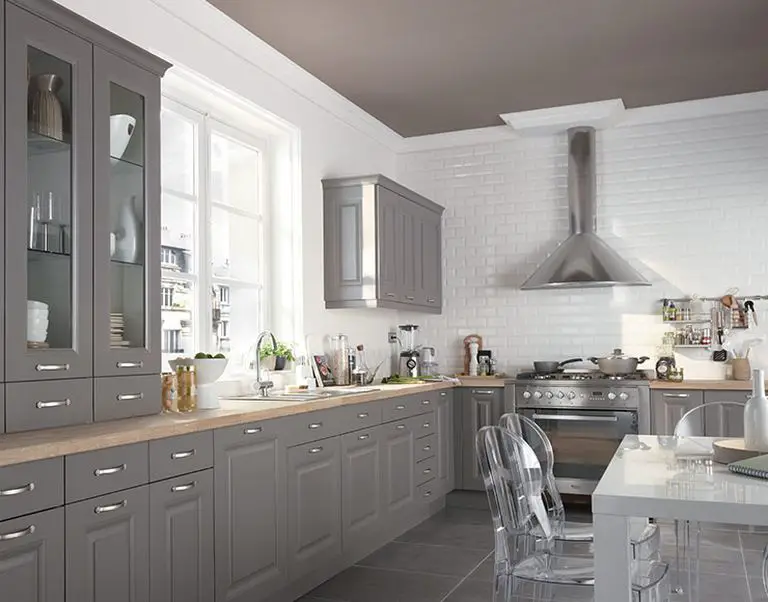You want to start painting your kitchen and you’re running out of ideas? Here are our tips on how to get started and how to know everything about it.
What Type Of Paint Should You Choose For Your Kitchen?
Once you’ve selected the colors for your kitchen, you need to choose the right type of paint. If you don’t choose the right type of paint, the colors won’t look like you expect them to. Moreover, the performance (durability and washability) may be less than outstanding.
Oil-based and water-based paints are the two main types of paints for residential use. The main difference between the two is in the cleaning of painting tools and equipment.
Oil-based paints are cleaned with solvents, such as mineral spirits or paint thinner. Water-based paints are cleaned with hot water and soap. Also, water-based paints have less odor than oil-based paints when applied and when they dry.
Oil-based paint was once considered the best choice because of its durability. However, it contains toxic volatile organic compounds (VOCs) that are released into the air as the paint dries.
What Kind of Paint for Kitchen
You also have a choice of finishes. Most paint manufacturers today offer three different finishes: matte, velvety, satin. All finishes are usually available in oil paint (if sold in your area) or water-based paint. Different spaces and elements in a kitchen have different needs and may require different finishes.
Satin paint is the most durable and the easiest to clean after drying because its hard surface is very stain resistant.
On the other hand, its gloss shows defects on the surface of the wall. The satin side is most often used on woodwork and trim, backsplashes (the vertical surface at the back of the countertop around the sink), and cabinets.
Satin paint is always a popular choice in kitchens. It is also a good choice for doors, trim, trim and cabinets. The satin finish has become very popular in the last twelve years.
Understand How Color Palettes Work
The biggest secret to good design is quite simple: a color chart. You might think they’re only for elementary school classes. However, color charts are perfect to help you understand the colors that go well together. Here are two ways to use a color wheel to decide on a color scheme.
A simple way to use a color wheel is to choose two colors that are opposite each other. Those are known to complement each other. Do not limit yourself to the primary colors (red, yellow and blue) and secondary colors (purple, green and orange).
There is an unlimited number of complementary colors to choose from. Three sections of the color wheel sitting together are called analogue colors.
This can mean that the scheme contains various shades of a primary color (such as dark red, medium red and light red). Alternatively, go for a color that blends into another (such as yellow, yellow-green and green).
There are many other ways to select a color palette using a color wheel. They include triadic and complement colors, which allows for a diverse palette.
Another tried and true way to choose a color palette is to use an image of nature. A natural image, such as a leaf or a wide-angle shot of a shoreline, usually produces five or six colors. Those can blend together and work in the same room.
How To Work with the Space You Have
Essentially, any combination of colors can be applied to any room, but you should carefully consider the size, shape and natural lighting of your kitchen before committing. If you have a small, narrow or low kitchen with little natural light, all dark shades will make the room oppressive and unwelcoming.
Therefore, you should choose a color scheme that incorporates a light “hue” as this introduces elements of white into the color, making it brighter, even when there are touches of darker shades.
Those who have a large kitchen with lots of natural light and a high ceiling can experiment with darker shades, as the amount of light and space available in the kitchen ensures that the room is always airy. In fact, applying too much white to a kitchen of this size can make it look lighter.
That means that lighter shades need to be balanced with warmer, darker tones.
While you don’t need to fully commit to a themed kitchen with this path, knowing the styles and trends you’d like to emulate will help you determine which colors you should use.
Once you’ve determined the palette you’d like to emulate, the shades and tones that will work in your kitchen, and a theme that will guide you, you’re ready to apply your color palette to the room!
What Kind of Paint for Kitchen – Support Elements
The walls, flooring and appliances you choose to include in your kitchen are just as important as the units and countertops, and can help flatter the plan you have chosen. Many people choose to have white or cream walls, as these work well as a neutral backdrop to the kitchen.
Other ideas include an assertive wall in a color that flatters the kitchen; a bright backsplash on the wall to add a touch of color, or even blackboard paint to create a quirky finish.
Floor covering is an important influencing factor in determining the appearance of your color palette. Wood floors add warmth to the room, which is ideal for those who prefer a traditional or natural design. At the same time, glossy and matte tiles are more modern and will give the room a contemporary finish.
Appliances and accessories can be a fantastic way to add color to an ordinary room. If you have chosen a kitchen that is predominantly white, a bright red oven will create impact and transform the room from a simple white to a more modern design.

